Abstract
We prospectively evaluated the use of peripherally inserted central venous catheters to provide ongoing venous access in general medical and surgical patients in a Department of Veterans Affairs medical center. Between 1985 and 1988 trained nurses successfully inserted 393 catheters in 460 suitable patients (an 85.4% success rate). Correct catheter tip placement in the superior vena cava was documented in 359 of the 393 (91.3%) catheter insertions, but an additional 30 catheters were in a position deemed adequate for the intended use. The mean duration of catheter use was 27.6 +/- 5.2 (1 standard deviation) days (median 20 days, range 1 to 370 days). A total of 65 patients left the hospital with catheters in place, with the mean length of catheter use at home being 36.2 +/- 6.0 days (range 2 to 266). In all, 79% of the catheters were in use until the successful completion of therapy or patient death; catheter-related complications led to premature catheter removal in the remaining 21%. Catheter-related complications included bland phlebitis (8.2%), occlusion (8.2%), local infection (3.6%), bacteremia or fungemia (2.1%), mechanical failure or rupture (2.6%), venous thrombosis (0.7%), and other (3.3%). One patient required vein excision for the management of suppurative phlebitis, but no deaths were attributed to catheter use. This study illustrates the use and safety of peripherally inserted central venous catheters to provide reliable vascular access over prolonged periods in an elderly veteran population. At our facility, percutaneous central venous catheters and surgically implanted (Hickman or Broviac) catheters are now reserved for use in patients in whom peripherally inserted catheters cannot be placed.
Full text
PDF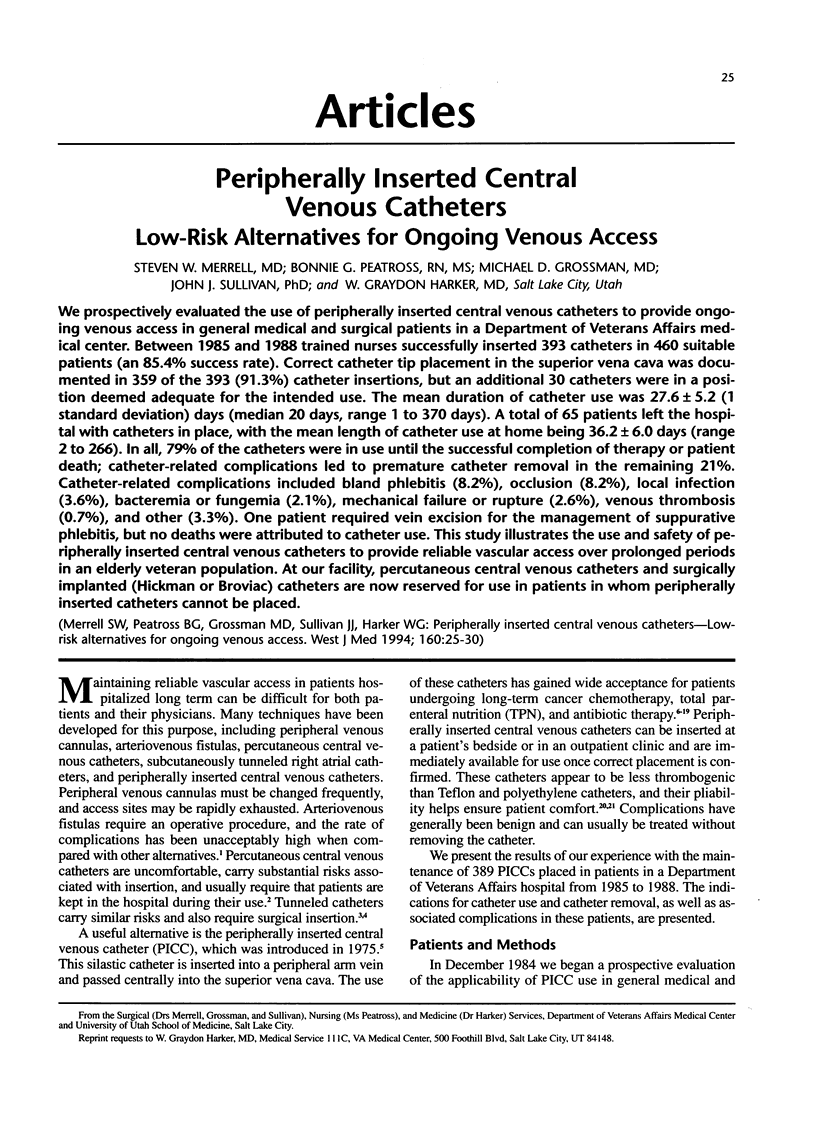
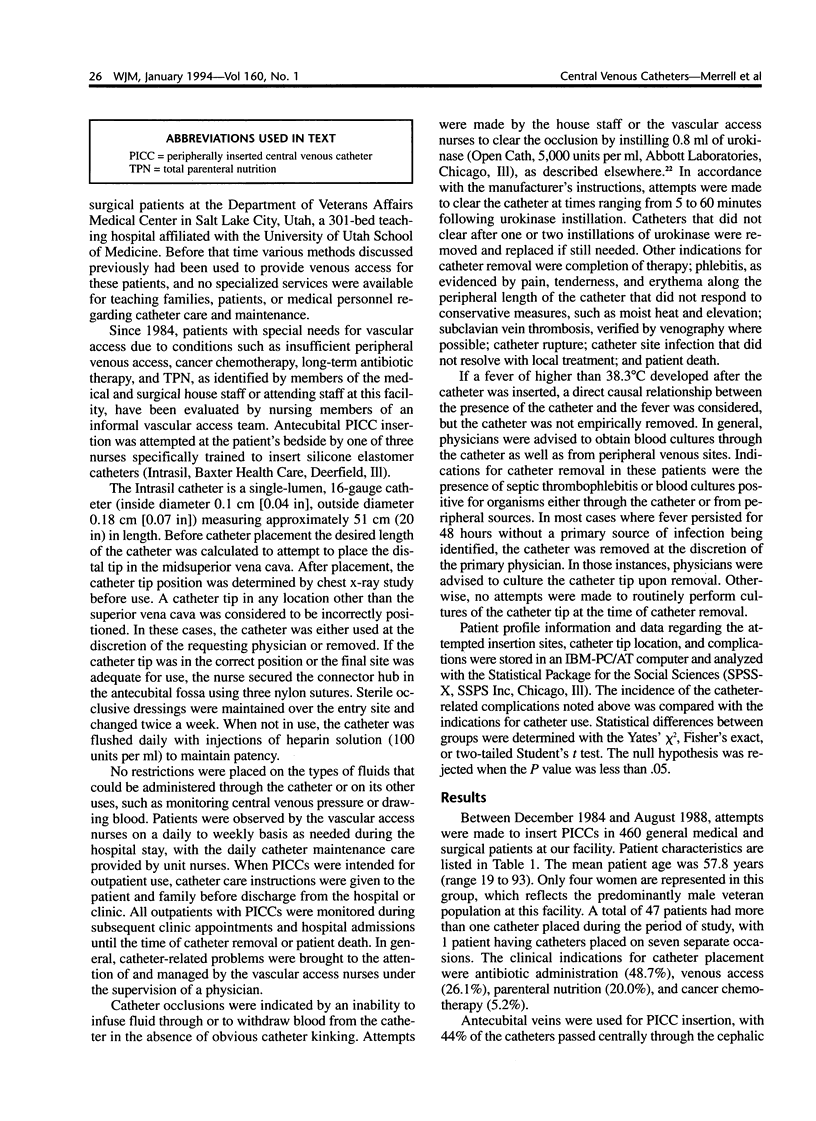
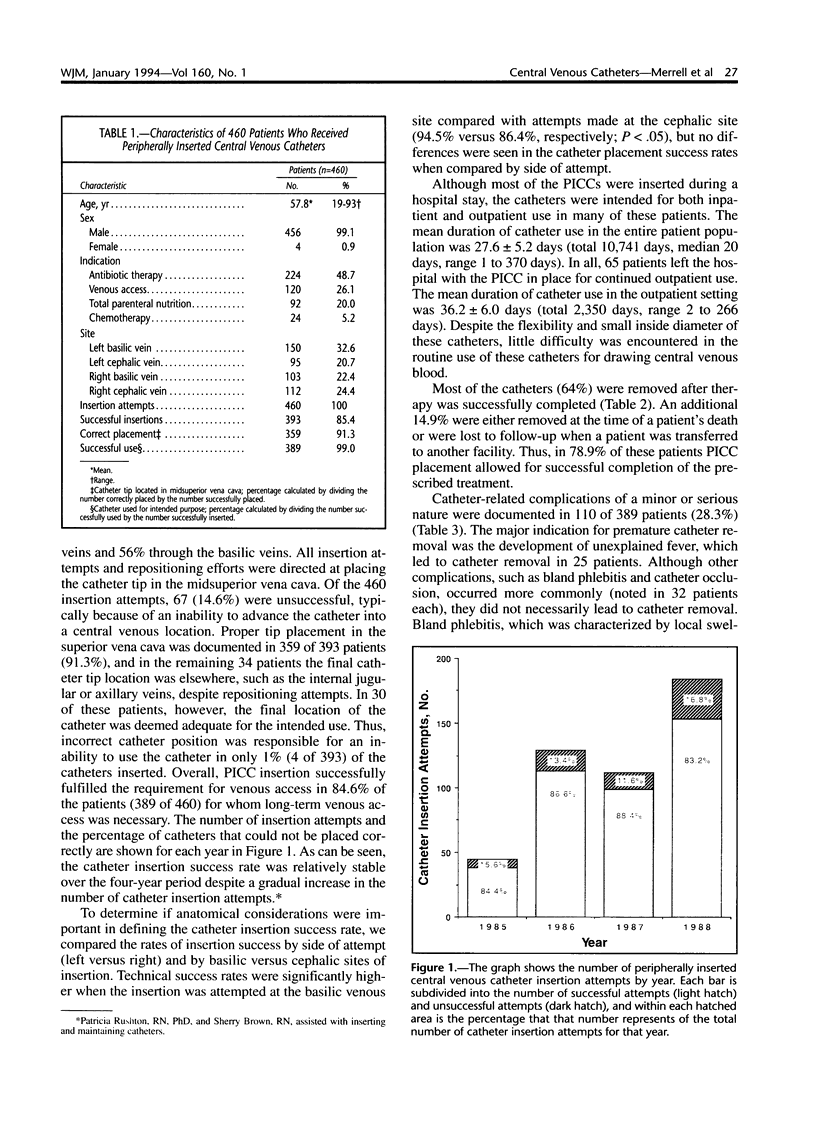
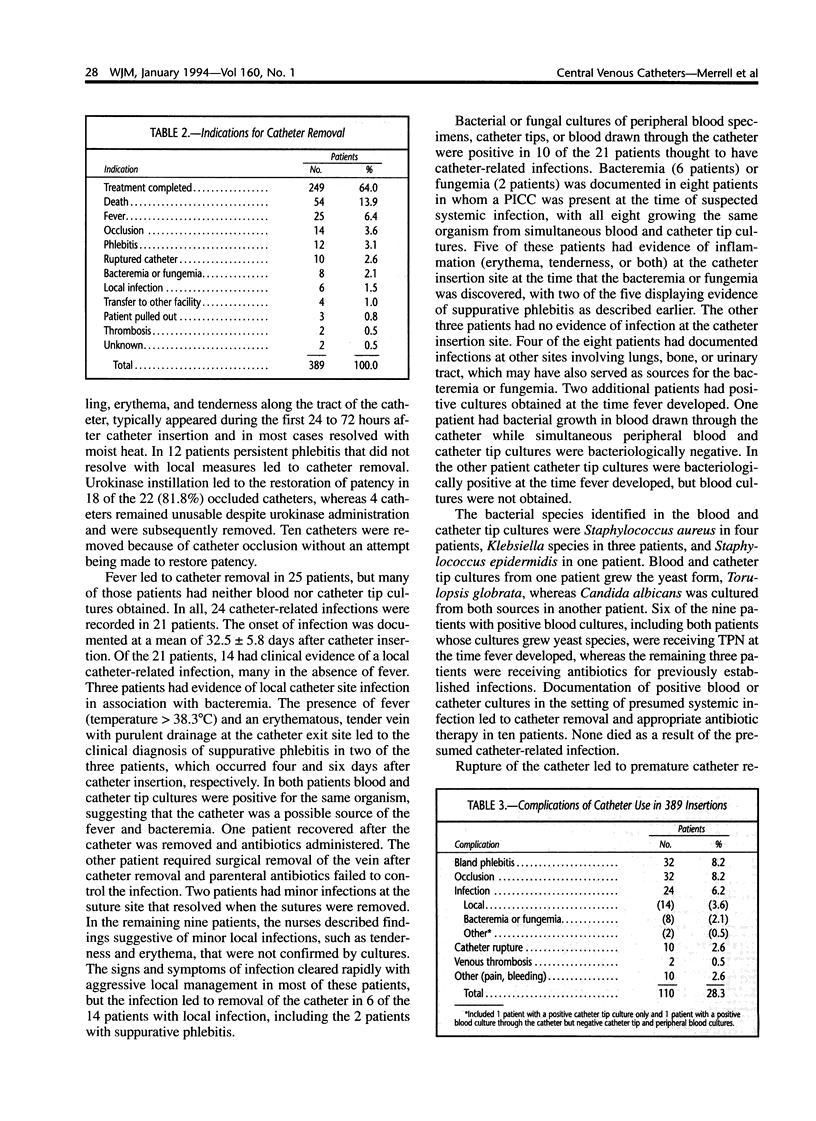
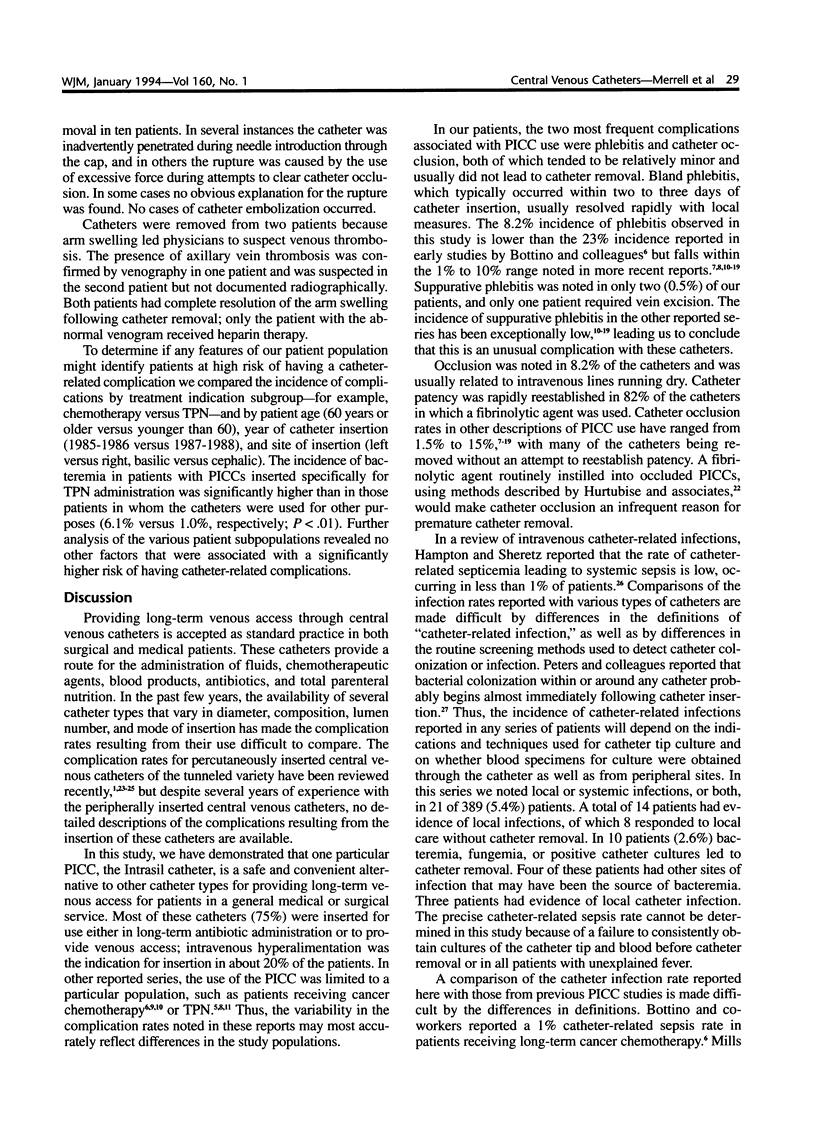
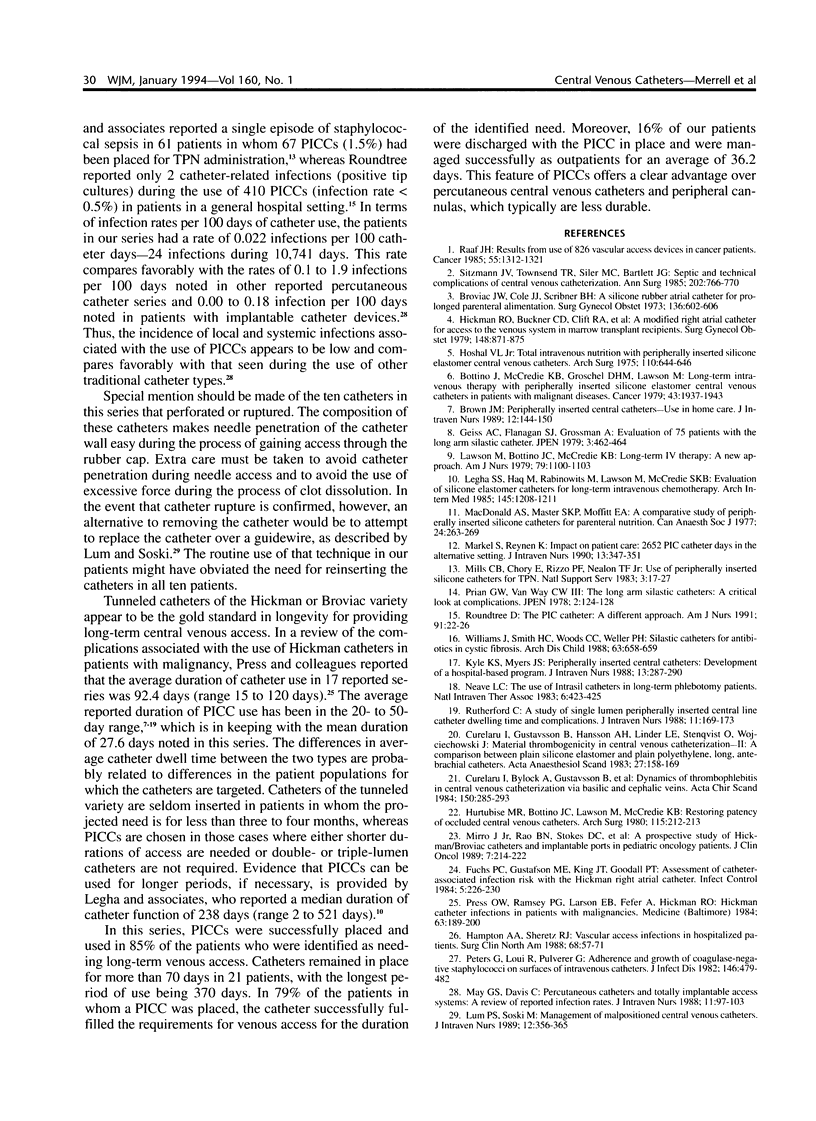
Images in this article
Selected References
These references are in PubMed. This may not be the complete list of references from this article.
- Bottino J., McCredie K. B., Groschel D. H., Lawson M. Long-term intravenous therapy with peripherally inserted silicone elastomer central venous catheters in patients with malignant diseases. Cancer. 1979 May;43(5):1937–1943. doi: 10.1002/1097-0142(197905)43:5<1937::aid-cncr2820430554>3.0.co;2-t. [DOI] [PubMed] [Google Scholar]
- Broviac J. W., Cole J. J., Scribner B. H. A silicone rubber atrial catheter for prolonged parenteral alimentation. Surg Gynecol Obstet. 1973 Apr;136(4):602–606. [PubMed] [Google Scholar]
- Brown J. M. Peripherally inserted central catheters--use in home care. J Intraven Nurs. 1989 May-Jun;12(3):144–147. [PubMed] [Google Scholar]
- Curelaru I., Bylock A., Gustavsson B., Hultman E., Linder L. E., Stefánsson T., Stenqvist O. Dynamics of thrombophlebitis in central venous catheterization via basilic and cephalic veins. Acta Chir Scand. 1984;150(4):285–293. [PubMed] [Google Scholar]
- Curelaru I., Gustavsson B., Hansson A. H., Linder L. E., Stenqvist O., Wojciechowski J. Material thrombogenicity in central venous catheterization II. A comparison between plain silicone elastomer, and plain polyethylene, long, antebrachial catheters. Acta Anaesthesiol Scand. 1983 Apr;27(2):158–164. doi: 10.1111/j.1399-6576.1983.tb01927.x. [DOI] [PubMed] [Google Scholar]
- Fuchs P. C., Gustafson M. E., King J. T., Goodall P. T. Assessment of catheter-associated infection risk with the Hickman right atrial catheter. Infect Control. 1984 May;5(5):226–230. doi: 10.1017/s0195941700060161. [DOI] [PubMed] [Google Scholar]
- Geiss A. C., Flanagan S. J., Grossman A. Evaluation of 75 patients with the long arm silastic catheter. JPEN J Parenter Enteral Nutr. 1979 Nov-Dec;3(6):462–464. doi: 10.1177/014860717900300612. [DOI] [PubMed] [Google Scholar]
- Hampton A. A., Sherertz R. J. Vascular-access infections in hospitalized patients. Surg Clin North Am. 1988 Feb;68(1):57–71. doi: 10.1016/s0039-6109(16)44432-4. [DOI] [PubMed] [Google Scholar]
- Hickman R. O., Buckner C. D., Clift R. A., Sanders J. E., Stewart P., Thomas E. D. A modified right atrial catheter for access to the venous system in marrow transplant recipients. Surg Gynecol Obstet. 1979 Jun;148(6):871–875. [PubMed] [Google Scholar]
- Hoshal V. L., Jr Total intravenous nutrition with peripherally inserted silicone elastomer central venous catheters. Arch Surg. 1975 May;110(5):644–646. doi: 10.1001/archsurg.1975.01360110190032. [DOI] [PubMed] [Google Scholar]
- Hurtubise M. R., Bottino J. C., Lawson M., McCredie K. B. Restoring patency of occluded central venous catheters. Arch Surg. 1980 Feb;115(2):212–213. doi: 10.1001/archsurg.1980.01380020078018. [DOI] [PubMed] [Google Scholar]
- Kyle K. S., Myers J. S. Peripherally inserted central catheters. Development of a hospital-based program. J Intraven Nurs. 1990 Sep-Oct;13(5):287–290. [PubMed] [Google Scholar]
- Lawson M., Bottino J. C., McCredie K. B. Long-term I.V. therapy: a new approach. Am J Nurs. 1979 Jun;79(6):1100–1103. [PubMed] [Google Scholar]
- Legha S. S., Haq M., Rabinowits M., Lawson M., McCredie K. Evaluation of silicone elastomer catheters for long-term intravenous chemotherapy. Arch Intern Med. 1985 Jul;145(7):1208–1211. [PubMed] [Google Scholar]
- Lum P. S., Soski M. Management of malpositioned central venous catheters. J Intraven Nurs. 1989 Nov-Dec;12(6):356–365. [PubMed] [Google Scholar]
- MacDonald A. S., Master S. K., Moffitt E. A. A comparative study of peripherally inserted silicone catheters for parenteral nutrition. Can Anaesth Soc J. 1977 Mar;24(2):263–269. doi: 10.1007/BF03006239. [DOI] [PubMed] [Google Scholar]
- Markel S., Reynen K. Impact on patient care. 2652 PIC catheter days in the alternative setting. J Intraven Nurs. 1990 Nov-Dec;13(6):347–351. [PubMed] [Google Scholar]
- May G. S., Davis C. Percutaneous catheters and totally implantable access systems: a review of reported infection rates. J Intraven Nurs. 1988 Mar-Apr;11(2):97–103. [PubMed] [Google Scholar]
- Mirro J., Jr, Rao B. N., Stokes D. C., Austin B. A., Kumar M., Dahl G. V., Colten M., Balas L., Rafferty M., Hancock M. A prospective study of Hickman/Broviac catheters and implantable ports in pediatric oncology patients. J Clin Oncol. 1989 Feb;7(2):214–222. doi: 10.1200/JCO.1989.7.2.214. [DOI] [PubMed] [Google Scholar]
- Neave L. C. The use of Intrasil catheters in long-term phlebotomy patients. NITA. 1983 Nov-Dec;6(6):423–425. [PubMed] [Google Scholar]
- Peters G., Locci R., Pulverer G. Adherence and growth of coagulase-negative staphylococci on surfaces of intravenous catheters. J Infect Dis. 1982 Oct;146(4):479–482. doi: 10.1093/infdis/146.4.479. [DOI] [PubMed] [Google Scholar]
- Press O. W., Ramsey P. G., Larson E. B., Fefer A., Hickman R. O. Hickman catheter infections in patients with malignancies. Medicine (Baltimore) 1984 Jul;63(4):189–200. doi: 10.1097/00005792-198407000-00001. [DOI] [PubMed] [Google Scholar]
- Prian G. W., Van Way C. W., 3rd The long arm silastic catheter: a critical look at complications. JPEN J Parenter Enteral Nutr. 1978 May;2(2):124–128. doi: 10.1177/014860717800200207. [DOI] [PubMed] [Google Scholar]
- Raaf J. H. Results from use of 826 vascular access devices in cancer patients. Cancer. 1985 Mar 15;55(6):1312–1321. doi: 10.1002/1097-0142(19850315)55:6<1312::aid-cncr2820550626>3.0.co;2-9. [DOI] [PubMed] [Google Scholar]
- Rutherford C. A study of single lumen peripherally inserted central line catheter dwelling time and complications. J Intraven Nurs. 1988 May-Jun;11(3):169–173. [PubMed] [Google Scholar]
- Sitzmann J. V., Townsend T. R., Siler M. C., Bartlett J. G. Septic and technical complications of central venous catheterization. A prospective study of 200 consecutive patients. Ann Surg. 1985 Dec;202(6):766–770. doi: 10.1097/00000658-198512000-00017. [DOI] [PMC free article] [PubMed] [Google Scholar]
- Williams J., Smith H. L., Woods C. G., Weller P. H. Silastic catheters for antibiotics in cystic fibrosis. Arch Dis Child. 1988 Jun;63(6):658–659. doi: 10.1136/adc.63.6.658. [DOI] [PMC free article] [PubMed] [Google Scholar]



